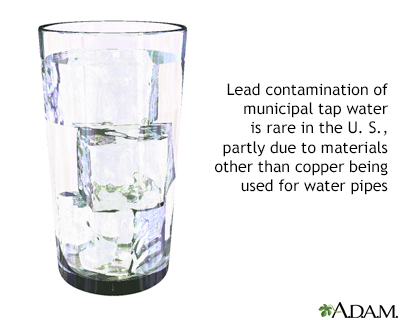Lead and tap water
Water contaminated with lead
Images

Information
The Safe Drinking Water Act requires the Environmental Protection Agency (EPA) to set and enforce standards to protect public drinking water systems. In the United States, the EPA set the maximum allowable concentration of lead in public drinking water at 15 mcg/L (micrograms per liter).
The EPA requires all water suppliers to produce a water quality report every year. These reports include information about lead amounts. The reports are available to the public.
The EPA requires public water systems to alert you if there is a problem with your drinking water.
Lead can enter drinking water when plumbing materials that contain lead corrode. Corrosion is when metal is dissolved or worn away by a chemical reaction between water and your plumbing. Water that has high acidity or low mineral content can corrode pipes and fixtures.
The most common sources of lead in drinking water are lead pipes, faucets, and fixtures. Service lines connect the home to the water main. In homes with lead service lines, these pipes are the main source of lead in the water. Lead pipes are more likely to be found in homes built before 1986. In homes without lead service lines, plumbing with lead solder can be a source of lead in the water.
How much lead enters the water depends on:
- The chemistry of the water and the types and amounts of minerals in the water
- The amount of lead the water comes into contact with
- The temperature of the water
- The amount of wear in the pipes
- How long the water stays in pipes
- The presence of protective scales or coatings inside the plumbing materials
For more information, call:
- EPA's Safe Drinking Water Hotline (800-426-4791)
- National Lead Information Center ( 800-424-5323)
References
United States Environmental Protection Agency website. Basic information about lead in drinking water. www.epa.gov/ground-water-and-drinking-water/basic-information-about-lead-drinking-water. Updated January 27, 2023. Accessed July 7, 2023.
BACK TO TOPReview Date: 7/1/2023
Reviewed By: Jesse Borke, MD, CPE, FAAEM, FACEP, Attending Physician at Kaiser Permanente, Orange County, CA. Also reviewed by David C. Dugdale, MD, Medical Director, Brenda Conaway, Editorial Director, and the A.D.A.M. Editorial team.

Health Content Provider
06/01/2025
|
A.D.A.M., Inc. is accredited by URAC, for Health Content Provider (www.urac.org). URAC's accreditation program is an independent audit to verify that A.D.A.M. follows rigorous standards of quality and accountability. A.D.A.M. is among the first to achieve this important distinction for online health information and services. Learn more about A.D.A.M.'s editorial policy, editorial process and privacy policy. A.D.A.M. is also a founding member of Hi-Ethics. This site complied with the HONcode standard for trustworthy health information from 1995 to 2022, after which HON (Health On the Net, a not-for-profit organization that promoted transparent and reliable health information online) was discontinued. |
The information provided herein should not be used during any medical emergency or for the diagnosis or treatment of any medical condition. A licensed medical professional should be consulted for diagnosis and treatment of any and all medical conditions. Links to other sites are provided for information only -- they do not constitute endorsements of those other sites. © 1997- 2024 A.D.A.M., a business unit of Ebix, Inc. Any duplication or distribution of the information contained herein is strictly prohibited.
